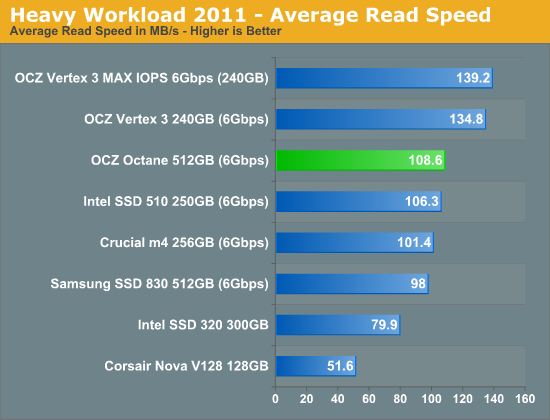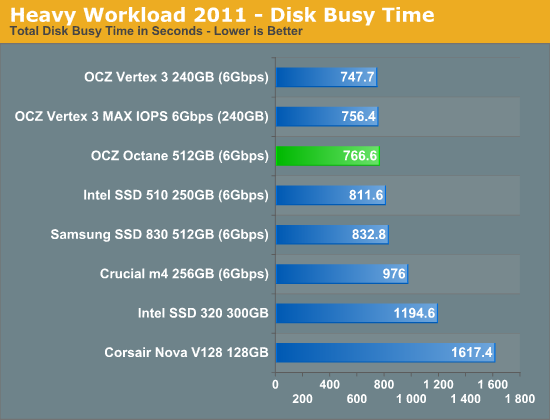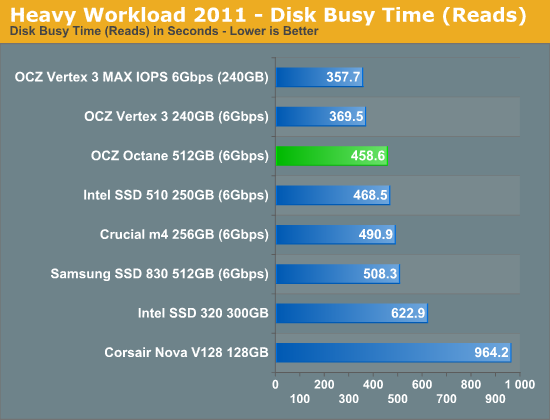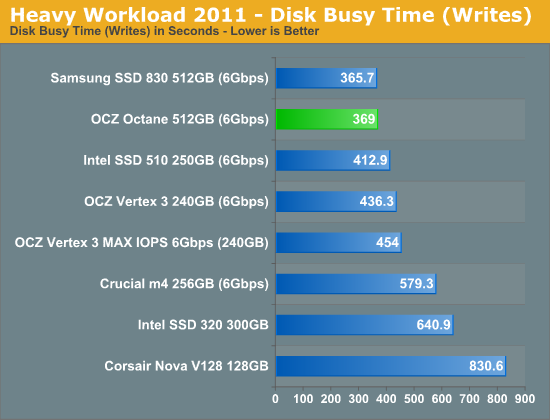The OCZ Octane Review (512GB)
by Anand Lal Shimpi on November 23, 2011 12:00 PM ESTAnandTech Storage Bench 2011
Last year we introduced our AnandTech Storage Bench, a suite of benchmarks that took traces of real OS/application usage and played them back in a repeatable manner. I assembled the traces myself out of frustration with the majority of what we have today in terms of SSD benchmarks.
Although the AnandTech Storage Bench tests did a good job of characterizing SSD performance, they weren't stressful enough. All of the tests performed less than 10GB of reads/writes and typically involved only 4GB of writes specifically. That's not even enough exceed the spare area on most SSDs. Most canned SSD benchmarks don't even come close to writing a single gigabyte of data, but that doesn't mean that simply writing 4GB is acceptable.
Originally I kept the benchmarks short enough that they wouldn't be a burden to run (~30 minutes) but long enough that they were representative of what a power user might do with their system.
Not too long ago I tweeted that I had created what I referred to as the Mother of All SSD Benchmarks (MOASB). Rather than only writing 4GB of data to the drive, this benchmark writes 106.32GB. It's the load you'd put on a drive after nearly two weeks of constant usage. And it takes a *long* time to run.
1) The MOASB, officially called AnandTech Storage Bench 2011 - Heavy Workload, mainly focuses on the times when your I/O activity is the highest. There is a lot of downloading and application installing that happens during the course of this test. My thinking was that it's during application installs, file copies, downloading and multitasking with all of this that you can really notice performance differences between drives.
2) I tried to cover as many bases as possible with the software I incorporated into this test. There's a lot of photo editing in Photoshop, HTML editing in Dreamweaver, web browsing, game playing/level loading (Starcraft II & WoW are both a part of the test) as well as general use stuff (application installing, virus scanning). I included a large amount of email downloading, document creation and editing as well. To top it all off I even use Visual Studio 2008 to build Chromium during the test.
The test has 2,168,893 read operations and 1,783,447 write operations. The IO breakdown is as follows:
| AnandTech Storage Bench 2011 - Heavy Workload IO Breakdown | ||||
| IO Size | % of Total | |||
| 4KB | 28% | |||
| 16KB | 10% | |||
| 32KB | 10% | |||
| 64KB | 4% | |||
Only 42% of all operations are sequential, the rest range from pseudo to fully random (with most falling in the pseudo-random category). Average queue depth is 4.625 IOs, with 59% of operations taking place in an IO queue of 1.
Many of you have asked for a better way to really characterize performance. Simply looking at IOPS doesn't really say much. As a result I'm going to be presenting Storage Bench 2011 data in a slightly different way. We'll have performance represented as Average MB/s, with higher numbers being better. At the same time I'll be reporting how long the SSD was busy while running this test. These disk busy graphs will show you exactly how much time was shaved off by using a faster drive vs. a slower one during the course of this test. Finally, I will also break out performance into reads, writes and combined. The reason I do this is to help balance out the fact that this test is unusually write intensive, which can often hide the benefits of a drive with good read performance.
There's also a new light workload for 2011. This is a far more reasonable, typical every day use case benchmark. Lots of web browsing, photo editing (but with a greater focus on photo consumption), video playback as well as some application installs and gaming. This test isn't nearly as write intensive as the MOASB but it's still multiple times more write intensive than what we were running last year.
As always I don't believe that these two benchmarks alone are enough to characterize the performance of a drive, but hopefully along with the rest of our tests they will help provide a better idea.
The testbed for Storage Bench 2011 has changed as well. We're now using a Sandy Bridge platform with full 6Gbps support for these tests.
AnandTech Storage Bench 2011 - Heavy Workload
We'll start out by looking at average data rate throughout our new heavy workload test:

When put to the test the Octane does not disappoint. It's within a couple MB/s of the SF-2281 based Vertex 3, and effectively one of the fastest 6Gbps drives on the market today. I included the old Indilinx Barefoot based Corsair Nova V128 to show just how far Indilinx has come here.


The next three charts just represent the same data, but in a different manner. Instead of looking at average data rate, we're looking at how long the disk was busy for during this entire test. Note that disk busy time excludes any and all idles, this is just how long the SSD was busy doing something:













75 Comments
View All Comments
Beenthere - Sunday, November 27, 2011 - link
Hopefully a year from now SSDs will be reliable and trouble free. Right now they ain't worth the hassles IMO. Marvel and Samsung controller based SSDs hold a lot more interest for me than SandForce or Indilinx, so we'll see how their reliability turns out.renosablast - Sunday, November 27, 2011 - link
More great info on this drive available here:http://thessdreview.com/
adamdz - Monday, November 28, 2011 - link
"Go above and beyond the call of duty in taking care of his customers and our readers".I had good experience with other companies that would still honor warranty a month or two after its expiration. OCZ wouldn't.
RohitK - Sunday, December 4, 2011 - link
"Most of my suggestions were obvious, just to go above and beyond the call of duty in taking care of his customers and our readers. He agreed to do everything on the list, with one exception."I bought a $220 Vertex 3 Max IOPS 120GB a couple weeks or so ago. It is my first SSD. I had to save up for some time to have enough to get the drive without starving for a while (I'm a grad student), so you can understand that it was a big deal for me.
All I got for my trouble was a lemon out of the box. I couldn't return the drive to Newegg because I had applied for a rebate already, so I was left to deal with OCZ directly. They took two days to respond to my "Trouble Ticket", and replied with directions to update the firmware and secure erase the drive (both things I'd already done before contacting them). After my response, their next contact came another two days later, telling me my RMA request was accepted and that they'd pass my info on to the RMA department, who will issue me an RMA number and then I can send the drive back. It's been five days since then now and I still haven't heard anything.
Also, I have to pay for shipping now to send the drive back to them. To top things off, until they get the drive back, they won't ship me a new one, with the only alternative being that they charge me for a new drive on my credit card and then refund me later. This, however, does nothing for me, since I don't *have* a credit card.
/rant
All in all, if I were you, Anand, I'd check again on how the company deals with its regular customers who aren't Anand Lal Shimpi before commending their CEO on a job well done. :-)
First comment, by the way. I'd just like to say thanks, like the millions of other people, for being the only source worth coming to for reliable info on hardware. You're a legend.
gamoniac - Monday, December 5, 2011 - link
Anand and AT,Do you plan on reviewing the new Kingston SSDNow V200? There isn't any beachmark on this series that I can find. It would be interesting to compare that to the OCZ Octane. Thanks.